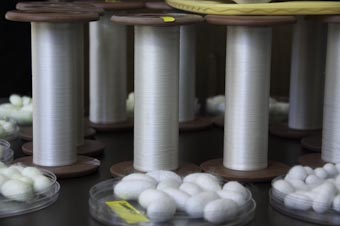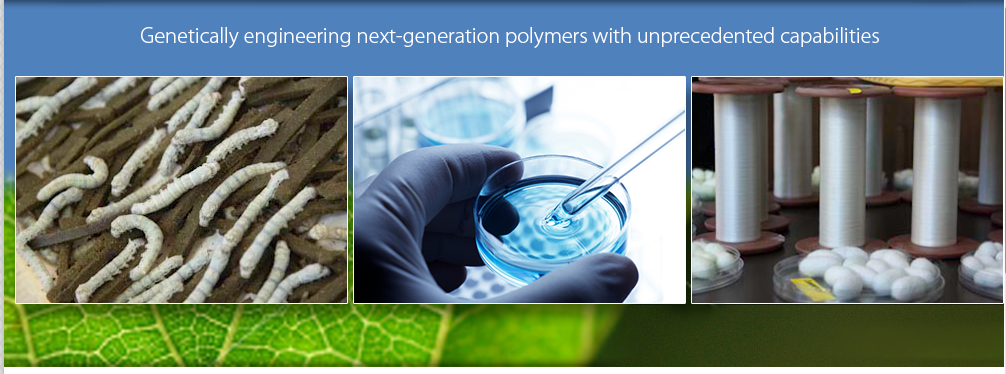Spider Silk | Research and Development | Compare Technologies
 Kraig Biocraft Laboratories, Inc. (Trading Symbol: KBLB) is applying its proprietary genetic engineering technology to find solutions in the areas of material science. We are developing genetically engineered spider silk which we believe will have broad applications for the multibillion dollar textile industry and in the market place for high-strength materials.
Kraig Biocraft Laboratories, Inc. (Trading Symbol: KBLB) is applying its proprietary genetic engineering technology to find solutions in the areas of material science. We are developing genetically engineered spider silk which we believe will have broad applications for the multibillion dollar textile industry and in the market place for high-strength materials.
Our investments in spider silk related genetic research are focused on product development and innovative near-term solutions to the practical problems of our world. These investments have resulted in our widely heralded success in developing recombinant spider silks and the first ever technology for commercial production of the same.
Life Science and Spider Silk Technology
Spider Silk is among the strongest fibers produced in nature. Some spider species are capable of producing up to seven different types of silk depending upon the spider’s particular need at that time. For example, a spider will use one type of silk to make the structural supports for its web, and another type to wrap its captured pray. Drag line silk, the silk used when a spider is rappelling, is of particular commercial interest. Spider silk, a natural polymer is both extremely strong and extremely flexible. These properties of the underlying polymer create the potential for exciting commercial opportunities.
Applications of Spider Silk and High-Performance Fibers
Spider silk holds the potential of a lifesaving ballistic resistant material; lighter, thinner, flexible and tougher than steel material. These mechanical properties are similar and yet exceed that of many of the high performance technical fibers that are currently on the market today. High performance technical fibers are currently used in a wide variety of military, industrial, and consumer applications requiring superior strength, toughness and flexibility. On this point, in 2016 Kraig Labs signed a contract with the U.S. Army for the development and delivery of ballistic shoot packs.
The Challenge: Production of Genetically Engineered Spider Silk
Hailed as one of nature’s most remarkable materials, spider silk is made when spiders spin liquid protein into solid fibers. While the superior properties of spider silks were well known, there was no known way to produce the fibers in commercial quantity. The spiders are cannibalistic, and cannot be raised in concentrated colonies. Until now, this technological barrier has stymied spider silk production.
Our Solution: Production of Genetically Engineered Spider Silk
At its inception, Kraig Labs obtained proprietary genetic engineering technology to unlock the mystery of producing spider silk. It was in early 2006 that the company obtained certain exclusive rights from the University of Wyoming to utilize the spider silk gene sequences in our field of use. This web site previously stated that the company was working to reduce its technology to practice. That changed with the public announcement of our success on September 29, 2010. We are currently ramping up production of our Monster Silk™ and Dragon Silk™ for commercialization and continuing to develop new and exciting recombinant spider silk fibers.
Monster Silk™ is the world’s first economically viable recombinant spider silk for textile use: a thin, lightweight, flexible and high strength fiber. Kraig is ramping up commercial scale production of Monster Silk™, the cleanest commercial alternative to the high strength technical textiles. We believe that this product will make significant inroads into both technical textile and mundane silk and apparel markets. The traditional silk market is estimated at approximately $3 to $5 billion (US) per year at the raw fiber level. Given its superior physical properties, Monster Silk™ is well positioned to penetrate that market, as well as the larger technical textile market which is estimated at approximately $130 billion (US).
In 2015, we announced a breakthrough: our Dragon Silk™ line of transgenic silkworms. It and its progeny have proven not only to be stronger and more elastic than commercial grade silkworm silk, but stronger and more elastic than certain spider dragline silks.
In 2016, we produced four new distinct transgenic lines, which use the most complex genetic designs in the company’s history. On top of the new lines, the lab also produced a new genetic insertion design for more effective gene splicing. This new design incorporated the properties of our Dragon Silk™ and Monster Silk™ into a single construction. This experiment to merge Monster Silk’s elasticity focus with the strength focus of Dragon Silk into a single package was the logical next step for the technology.
In 2016 Kraig Labs secured its first material development and delivery contract from the US Army. Under this contract, Kraig Labs will providing the Army with ballistic shoot packs and silk fibers for testing and evaluation.

